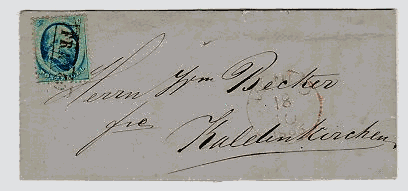
Local Letters. The Netherlands International Mail.
By Erling Berger
It is very popular to collect international "local letters". After an unsystematic start 1 April 1851 the final explanation came 1 April 1852 via the postal convention between Belgium and the Netherlands.
The final explanation ended up being like this:
Local Letters are sent between two offices situated in two different countries with a distance across the common border not exceeding a certain limit. (50 or 30 Kilometers)

Map showing the 30 km range with Germany and the 30 and 50 km border ranges with Belgium ("Veendamphila 1983")
1851 Prussia-Netherlands convention
The first appearance of "local letters" was in the 1851 Prussia-Netherlands convention that listed around 25 pairs of post offices having a postage of 5 cent between them. At least one of the following two conditions should be fulfilled to let a pair of post offices have a local postage:
- Either the offices were near the common border and were exchanging mail directly between them, Examples: Arnhem-Emmerich, Maastricht-Aachen, and Enschede-Gronau
- or the two offices were just close in distance. Example Enschede-Ochtrup
Any other pair of offices had a postage of from 10 to 30 cent.

Fig 1. 1860. Unfranked letter Emmerich-Arnhem
.Local postage "5" cent -written by ink on the front of the letter
1851 Hanover-Netherlands agreement
The 1851 Hanover-Netherlands agreement announced four pairs with local postage of 5 cent:
-Winschoten with Bunda and Weener
- Oldenzaal with Nordhorn and Bentheim
The pairs were all near the common border and were exchanging mail directly between them. The town Hannover and Arnhem also exchanged mail directly, but the distance was too far.
1852 Belgium-Netherlands convention
The 1852 Belgium-Netherlands convention sat up as only condition for local postage that the distance was less than 50 km (giving a local postage of 10 cent). The normal uniform postage was 20 cent. As an example: Maastricht had in 1852 local postage with 43 different offices in Belgium, of which the more important were: Liège, Huy, Maaseyck, Spa, and Verviers.

Fig. 2 Bergen op Zoom - Antwerp
Unfranked single Local letter.Uniform rate (1.4.1852 - 30.6.1865) "2" décimes (which is the equivalent of 10 cents)

Fig. 3 1854 Maastricht -Huy
Unfranked single Local letter.Uniform rate (1.4.1852 - 30.6.1865) "2" décimes (which is the equivalent of 10 cents)
1854 Hanover-Netherlands convention
The 1854 Hanover-Netherlands convention announced seven pairs with local postage of 5 cent:
- Winschoten with Bunda and Weener
- Oldenzaal with Nordhorn, Gildeshaus and Bentheim
- Nieuwe-Schans with Bunda and Weener
The pairs were all near the common border and were exchanging mail directly between them.
The Netherlands circulars could from time to time report of new pairs with local postage.
1864 Prussia-Netherlands convention
In 1864 Prussia and the Netherlands agreed upon a max. distance of 30 km as the only condition for local postage (5 cent for franked - and 10 cent for unfranked letters).

Figure 4: 1866, Venlo - Kaldenkirchen. Franked single letter. Fixed local postage
(1851-1919) 5 cent
1865 Belgium-Netherlands convention
The 1865 convention with Belgium introduced a 30 Km max. distance. The local postage was now 5 cent for franked - and 10 cent for unfranked letters. Maastricht had in 1865 local postage with 27 different offices in Belgium, of which the more important were: Liège, Maaseyck, and
Verviers. Spa and Huy were no longer on the list.
1865 Hanover-Netherlands convention
In 1865 Hannover and the Netherlands agreed upon the max. distance of 30 km as the only condition for local postage (5 cent for franked - and 10 cent for unfranked letters).
The system with local postage continued:
-with Belgium - until 1947
- with Germany - until 1966 (not active 1942-45)

Figure 5: 1878, Aachen-Vaals
. Franked single letter. Fixed local postage (1875-1919) 10 Pfennige. Prussia became a part of NDP 1868 (North German Post Area) and of Deutsches Reich 1872Sources:
Netherlands circulars 1851-1865
W.S. da Costa: Binnenlandse en Internationale Posttarieven van Nederland 1850-1990.
The 1983 Veendam exhibition catalog has an annexed booklet with a complete listing of the offices with local postage.
ARGE Niederlande: "Postvertraege ....1863....1868" has complete lists of German offices with local postage versus the Netherlands. The Hannover group of offices is included in the 1868 list concerning the North German Post Area . Prussia conquered the Kingdom of Hannover in 1866.
Both states became later parts of the North German Post Area from 1868, (Area = Bezirk)